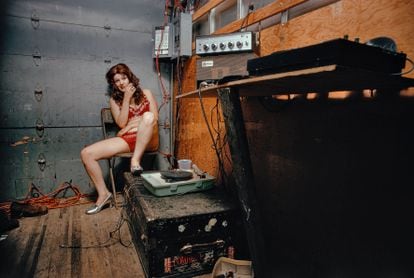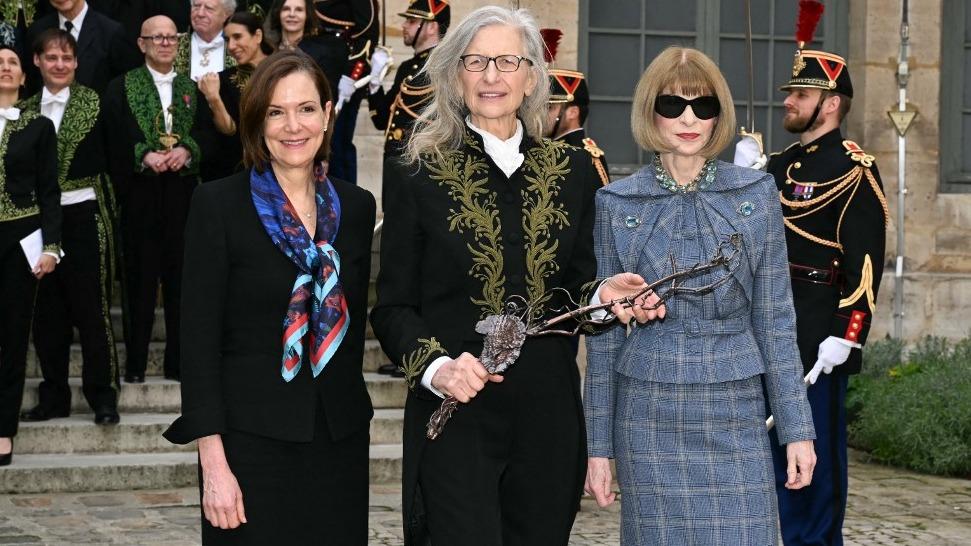Over four years, in the seventies, Susan Meiselas (Baltimore, 1948) delved into the life of a group of female
strippers
who, from town to town, toured the west coast of the United States.
At that time the artist was in her mid-twenties.
Although she taught photography classes at an elementary school in the Bronx, her commitment to the medium was yet to be decided, but that immersion in an underworld shaped by the starving male gaze would eventually seal her fate.
Carnival Stripper,
the photographic series that she undertook in those days would open the doors of the Magnum agency to the photographer, marking the parameters that still define her photography.
In 1976 her images would be collected in a book that many refer to as one of the most decisive photographic projects of the second half of the 20th century.
After a reissue in 2003, the Steidl publishing house launches a new and expanded version that will accompany
Mediations
, the retrospective dedicated to the artist that opens on April 30 at the C/O in Berlin.
Tunbridge, Vermont.
1974.Susan Meiselas/Magnum Photos/Courtesy Steidl
Lena during a break.
Vermont.
Essex Junction.
September 1973.usan Meiselas/Magnum Photos/Courtesy Steidl
The Managers.
Essex Junction, Vermont, 1974. Susan Meiselas/Magnum Photos/Courtesy Steidl
Before the show.
Tunbridge, Vermont, 1974. Susan Meiselas/Magnum Photos/Courtesy Steidl
Aguilares Highway.
El Salvador, 1983. Susan Meiselas / Magnum Photos (©Susan Meiselas / Magnum)
Sandinista on the walls of the National Guard barracks in Estelí, Nicaragua, July 16, 1979. Susan Meiselas / Magnum Photos
Self portrait.
44 Irving St.
Cambridge.
Massachusetts, 1971. Susan Meiselas / Magnum Photos
Pebbles with Enzo and Tina at the Carmine Street pool.
Little Italy, New York.
1978.Susan Meiselas/Magnum Photos
The
strippers
' ages were between 17 and 35 years old.
They earned $15 to $50 a day to work on a truck that was transformed into two stages each night, one open to the general public and the other camouflaged under a tarp.
Dressed in colorful sets of underwear, they swayed their bodies attracting the attention of a crowd of spectators;
self-absorbed teenagers, some couples and, above all, men.
The latter were the only ones who had access to a more reserved show that was advertised as red, hot and spicy.
"Do yourself a favor," the presenter yelled at the women mingling in the audience.
“Do her husband a favor, Buy her husband, her boyfriend, or someone else's husband, a ticket.
Give him two dollars and let him in to see the
Show.
We guarantee that when you go out you won't want to go fishing on the weekend."
Little by little, the photographer managed to get closer and gain the trust of the dancers, who facilitated her entrance to their uninhibited exhibitions and to the before and after shows.
She accompanied them in their comings and goings through motels, in their talks, in their card games and in their moments of despair, rest and reflection.
“My approach was very cinematographic”, highlights the author in a conversation she had with Felix Hoffmann, curator of the exhibition and editor of the new publication.
She wanted to "capture the feeling of an open road, of the unpredictable life that these women were forced into."
Thus, through an approach that is as empathetic as it is objective,
Meiselas offers a crude document that investigates the contradictory reality of some young women whose work guaranteed them not only an economic income but also a path to freedom and emancipation from the traditional roles that surrounded women in those days, while submitting them to to objectification and exploitation.
Hence, the author presents us with a double reality where tender moments coexist with those in which pornography is touched.
Moments where the early skill of the author is evident, the search for barely perceptible features that determine an instant, as well as her insistence on approaches about the game of power and the imbalance that is established between the photographer and her model.
The images are complemented and enriched by the written testimony of the different actors that make up the scene;
the dancers, their boyfriends, the business owners and the public.
The amount of archive material accumulated during that process gives an idea of the depth and rigor that the photographer puts before her artistic gaze.
An approach that could be understood as an ethnological study.
To the 150 hours of recorded conversations were added as many written down in multiple notebooks.
Testimonials that, together with the hundreds of contact sheets, maps, correspondence and other types of documents, have been revised to give shape to
Making Off
, a new complementary publication that also includes the unpublished images made in color by the author, which is presented together with to the monograph inside a slipcase.
Lena during a break.
Vermont.
Essex Junction.
September 1973. © Susan Meiselas / Magnum Photos/ Courtesy Steidlusan Meiselas / Magnum Photos / Courtesy Steidl
“It should be noted that when Meiselas accessed Magnum, the agency was totally controlled by men,” Hoffmann points out during a telephone conversation.
She “she She was one of the few women who came to work with men as powerful as Cartier-Bresson or René Burri, among others.
She presented them with a project carried out over the years that showed the naked woman before the man's gaze.
A subject that was then very unusual to be developed by a woman at a fair.
As rare as the fact that she interviewed her models.
She proposed a type of exchange that we now refer to as collaboration.
The density and depth of this work is very illustrative for the new generations, since it points to the need to enter the dialogue and learn about the lives of the subjects.
It is not enough to just take pictures for a few days and leave.
For Meiselas, the way in which photography captures history is very important.
His work is not the result of something sudden but places the viewer within a historical and social context”.
That first publication had a bad impression.
"The book was made with an educational purpose above all," adds the curator.
“It dealt with a somewhat hidden subject.
Something that few were willing to see in the United States.”
The monograph was well enough received within the photographic community that another edition was published in France.
“At that time themes such as nudity, intimacy, sexuality and violence, as well as those dealing with the lives of social groups outside the margins, had hardly been recognized in photography, or in sociological debates on the subject. social landscape, with exceptions such as
The Bikeriders
(1968), by Danny Lyons and
Tulsa
(1971), by Larry Clark”, highlights Hoffmann.
"We are not sensual when we are on stage," complains Lena, one of the
strippers
with whom the photographer managed to maintain more closeness.
“We may be sexy, but not sensual.
Sensual is a beautiful word.
Sexy sounds like plastic.
It is a false and ugly word.
When I don't work I feel sensual.
When I work, I feel sexy.”
Meiselas alludes to the theme of the male gaze from different perspectives.
Among other things, the series deals with “how women perceive themselves.
I watched them and they watched how they were watched," says Meiselas, "but at the same time they were expressing themselves as they were, and that was what intrigued me the most."
So
Carnival Strippers
explores how the process of representing oneself and others refracts through different layers.
“To be honest, men are the actors.
Women are the audience”, pointed out one of the interviewees.
"It 's the men's
show
I'm going to see, not mine."
“On the one hand, it was difficult for Meiselas to be recognized as a female photographer, but on the other, she had a lot of freedom, since there were so few women in the profession, no one really cared about her,” Hoffmann notes.
The male gaze becomes very important in this work.
The interaction established through this gaze was part of a value system.
The men who attended these fairs actually used women as objects.
This is something and it shows very clearly in the contacts.
They were dressed and surrounded by carnival stalls where they were shooting with rifles, and there in the middle were these young women undressing.
Self portrait.
44 Irving St.
Cambridge.
Massachusetts, 1971. USA.
Cambridge, Mass.
1971. 44 Irving St. © Susan Meiselas / Magnum PhotosSusan Meiselas / Magnum Photos
Carnival Strippers
will serve the artist to consolidate her consideration of photography as a dialogue.
A two-way path that forces her to establish long-term bonds with her subjects and to never observe them as an object.
Approaches that will have continuity in his later works, such as those made in Nicaragua and Kurdistan or in
Prince Street Girls (1975-1992)
, where he documents the life of some teenagers in New York, as well as in
Archives of Abuse (1991-1992) .
)
and
A Room of Their Own (2015-2017)
, where she delves into domestic violence.
They are all part of
Mediations,
the largest retrospective held on the artist in Europe.
An exhibition that takes its title from one of the projects carried out by the author in Nicaragua and El Salvador during the eighties.
In it,
Sandinista on the walls of the Estelí National Guard barracks (1979)
, one of the most iconic images of the artist, a symbol of revolution and resistance, and reproduced ad nauseam on posters, t-shirts and all kinds of objects, is used to show how the circulation of images within society alters their initial meaning.
“A photographer can never calculate the direction that his images will take and this is one of the questions that the documentary photographer faces”, highlights the curator.
“How to work as a photographer”, asks Meiselas.
“There is always the uncomfortable imbalance of power.
How to knock it down?
How to turn it into a dialogue?
'
Carnival Strippers
', Susan Meiselas.
Steidl.
305 pages.
85 euros.
'
Susan Meiselas, Mediations
'.
C/O Berlin.
Berlin.
Until September 9.
You can follow BABELIA on
and
, or sign up here to receive
our weekly newsletter
.












